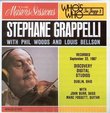| All Artists: Gerhard Hüsch, Heinrich Schlusnus, Herbert Janssen, Willi Domgraf-Fassbaender, Karl Hammes, Alfred Jerger, Leo Schutzendorf, Ernesto Badini, Afro Poli, Mariano Stabile, Jr. Mario Basiola, Marco Basiola, Apollo Granforte, Cesare Formichi, Carlo Galeffi, Benvenuto Franci, Giovanni Inghilleri, Carlo Tagliabue, Riccardo Stracciari, Luigi Borgonovo Title: The EMI Record of Singing, Vol. 3 1926-1939 [Box Set] Members Wishing: 0 Total Copies: 0 Label: Testament UK Original Release Date: 1/1/1999 Re-Release Date: 12/14/1999 Album Type: Box set, Import Genres: Folk, Special Interest, Classical Styles: Opera & Classical Vocal, Forms & Genres, Theatrical, Incidental & Program Music, Historical Periods, Baroque (c.1600-1750), Classical (c.1770-1830), Modern, 20th, & 21st Century, Romantic (c.1820-1910) Number of Discs: 10 SwapaCD Credits: 10 UPC: 749677013226 |
Search - Gerhard Hüsch, Heinrich Schlusnus, Herbert Janssen :: The EMI Record of Singing, Vol. 3 1926-1939 [Box Set]
![The EMI Record of Singing, Vol. 3 1926-1939 [Box Set]](https://nationalbookswap.com/cd//l/26/0726/6130726.jpg) | Gerhard Hüsch, Heinrich Schlusnus, Herbert Janssen The EMI Record of Singing, Vol. 3 1926-1939 [Box Set] Genres: Folk, Special Interest, Classical |
Larger Image |
CD DetailsSimilar CDs |
CD ReviewsEssential survey Anthony Clarke | Woodend, Victoria Australia | 01/14/2000 (5 out of 5 stars) "Well, it does seem a lot of money for one CD! In fact, although Amazon's resident typo gremlin counts it as one CD, it's really a box set of 10 CDs and as soon as I can, I'll be buying it! I have had the LP box set of this survey of world singing for many years and it, plus Volume 4 (which is on the EMI label on 7 cds) gives a fantastic summary of the greatest singers of the first half of the 20th Century. They are divided by singing category -- from soprano through to bass -- and Testament, which has done a great job in bringing from darkness some of the gems of the EMI back-catalogue, have brought us here one of the greatest singing compilations ever assembled. It's an aural history of immeasurable value -- 10 discs of this quality is a bargain! Anthony Clarke Sydney Australia" The EMI Record of Singing Formertenor | Wyomissing, Pennsylvania United States | 04/23/2002 (5 out of 5 stars) "An installment in the ultimate collection of opera and concert singer recordings. If you really want to know how the great singers of the first half of the 20th century -- virtually all of them who recorded -- sang, this is the set. By 1926 (the beginning date here) the electrical (as opposed to acoustic) recording system was in general use. Unlike the recording horn, the microphone was able to capture a pretty faithful impression of the singers sound and style, including dynamic nuances and tone shadings. Many of these singers were near the end of a long career, and had studied with the great bel canto teachers. There's a huge variety of music here, and huge variety of singing styles. Makes you realize how similar everyone sounds today -- the cult of tyrannical conductors and the mass media marketing has caused today's singers to sing everything the same way: almost all the sopranos today sing "Un Bel Di" or an art song the same way, for example.So fork out your money and buy this set while you can. Soon the mass media will have stamped out the few remaining classical music radio starions and the only way you'll be able to hear good music is by listening to your own collection." ONE OF THE GREAT TREASURE-HOUSES OF THE GRAMOPHONE Klingsor Tristan | Suffolk | 04/18/2007 (5 out of 5 stars) "This series, produced by EMI in the days of LPs, is one of the great achievements of the gramophone - they rightfully belong up there with the Decca Ring, the EMI Callas series, and any other candidates you care to name. Together they provide a truly comprehensive survey of singing right through the age of recording up to the early days of the LP. Sadly, to the best of my knowledge, only Volumes 3 & 4 have appeared on CD - the very earliest era of recording and the period up to the introduction of electrical recording methods that were originally on Volumes 1 and 2 really deserve to be heard again.
Volume 3, the collection under discussion here, covers the period from 1926-1939. This was a veritable Golden Age of Singing - in Wagner it was the era of Leider, Schorr and Melchior; the Italian School included the likes of Gigli, Muzio and Pinza and so it goes on through a broad representative range of French, English and Slavic singers. One of the great strengths of this series is that the best-known singers tend to be represented by less familiar repertoire, so it's more unlikely that collectors will duplicate material they already know well. And, of course, there is a huge range of other singers you probably won't have heard and some you may well not even have heard of. They all have something to tell us, though, about the times in which they worked, the styles of singing that were current then and the high standards that prevailed in the inter-war years. In some ways, the most surprising thing here is the strength in depth of the less familiar Schools, the French and the Anglo-American. It is good to be reminded just how good the likes of Georges Thill, Eide Norena or Pierre Bernac were - or from the UK, Isobel Baillie, Walter Widdop and Heddle Nash. Then there are the discoveries like the delightfully named Lulu Mysz-Gmeiner in a Brahms folksong or the black American, Roland Hayes, who sings Monteverdi with piano accompaniment totally unauthentically by today's standards, but with an attractive reedy tenor voice that reminds me a lot of the underrated Wilfred Brown. This set, now available from Testament, is a real treasure-trove. The transfers are all well-researched and of the highest quality. Anyone with an interest in how the art of singing has evolved over the last hundred years or so, or who just has a passion for glorious singing, should snap up this set of CDs - especially this volume as it displays a Golden Age of Singing." |




